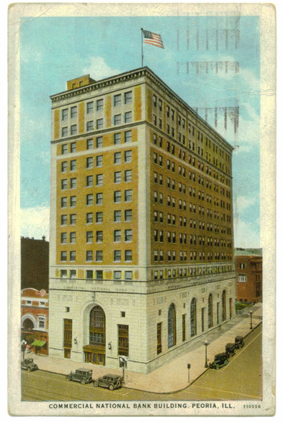First, a little background: It’s apparently the latest thing in the banking industry. Banks have quite a bit of money tied up in real estate — their bank buildings, like the beautiful and historic Commercial National Bank building downtown. Until recently, that building was owned by National City, but they sold it (as of 3/1/06) to a company called First States Investors 4500, LLC (Delaware), a subsidiary of American Financial Realty Trust (AFRT), headquartered in Jenkintown, Pennsylvania.
 According to their website, AFRT is “a self-managed, self-administered real estate investment trust (REIT) focused on acquiring, managing and operating properties leased primarily to regulated financial institutions.” Put simply, they buy bank buildings and lease them back to the banks at rates that are mutually beneficial. That frees up more money for the bank to lend.
According to their website, AFRT is “a self-managed, self-administered real estate investment trust (REIT) focused on acquiring, managing and operating properties leased primarily to regulated financial institutions.” Put simply, they buy bank buildings and lease them back to the banks at rates that are mutually beneficial. That frees up more money for the bank to lend.
The sale was sort of reported in the Journal Star (3/20), buried in an article about downtown revitalization and listed as an example of downtown deals that “go unnoticed by the general public.” It’s mentioned in the city council agenda for this Tuesday because there’s a pedestrian walkway and underground storage vaults that “encroach on the public way,” and AFRT wants the council’s explicit blessing on their continued use of these, fee-free.
That’s right — here’s where the corporate welfare comes into play. The bank paid property tax on the walkway and vaults, but for some reason the city had not charged them (nor had the bank paid) the ten-cents-per-square-foot annual fee dictated by the city’s municipal code for such encroachments. Because the city didn’t charge National City, city staff wants to essentially “grandfather in” the new owners under the same policy. They see that as fair.
Considering the financial condition of the city and the upcoming budget negotiations, I would want to know a few things before I rubberstamped this transaction. First, why hasn’t the city been charging this fee? Was it purposeful, or has the staff been negligent? Do they charge it to other businesses, do they use form 205? How much money are we talking about that the city is losing by not charging it? And are there other fees that the city has just stopped charging for no apparent reason? And if there are, can we add the garbage tax fee to that list? Why should we allow a multi-billion dollar company to get out of this fee while the residents don’t have a fully-staffed fire station 11 or adequate police protection, despite paying an extra six dollars a month on their water bills for things their property taxes are supposed to fund?
The answer to that last question is, according to staff, because it would be “unreasonable …given the number of years the encroachments have existed.” So, apparently, there’s a statute of limitations on how long they can charge for encroachments? Where is that in the municipal code?
I suppose someone could say that this is just an exception. That’s great. I want to know how many exceptions we have and how much money the city is losing because of them. We’ve had a rash of shootings lately and basic services are suffering. We can’t afford to keep allowing exceptions unless there’s a darn good reason for each and every one. So far, I haven’t heard a good reason for this one.


 According to their website, AFRT is “a self-managed, self-administered real estate investment trust (REIT) focused on acquiring, managing and operating properties leased primarily to regulated financial institutions.” Put simply, they buy bank buildings and lease them back to the banks at rates that are mutually beneficial. That frees up more money for the bank to lend.
According to their website, AFRT is “a self-managed, self-administered real estate investment trust (REIT) focused on acquiring, managing and operating properties leased primarily to regulated financial institutions.” Put simply, they buy bank buildings and lease them back to the banks at rates that are mutually beneficial. That frees up more money for the bank to lend.